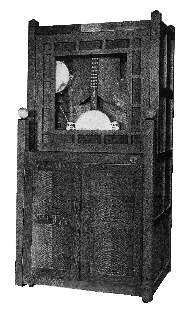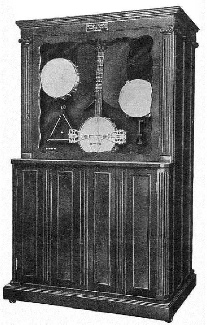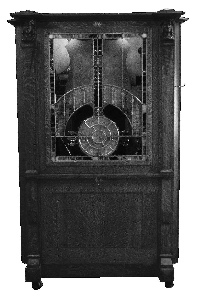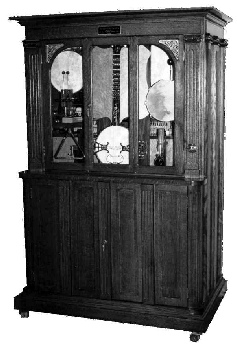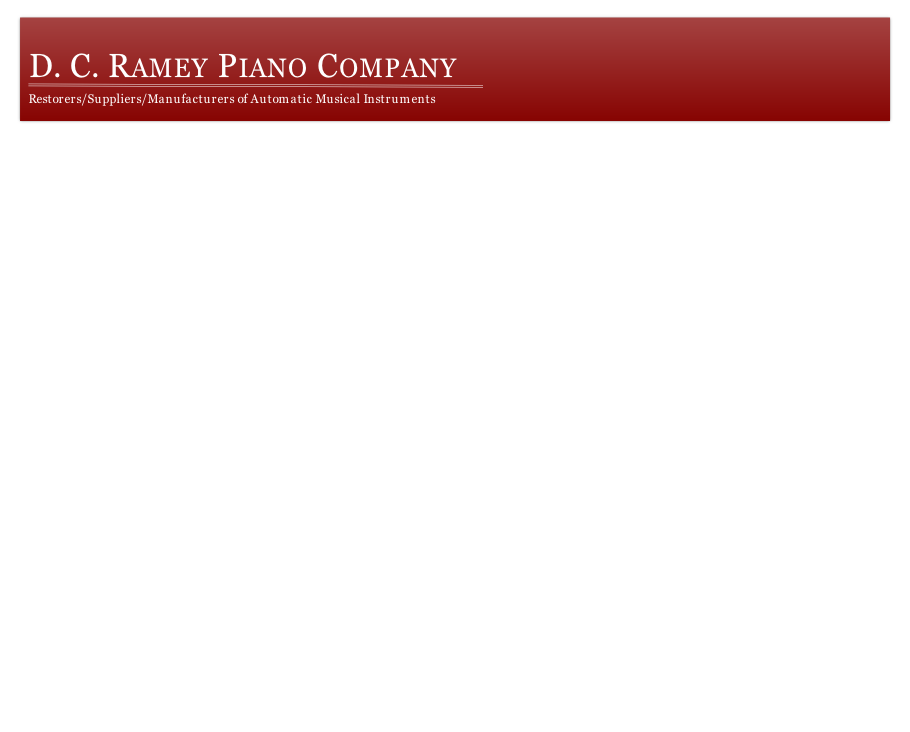
Copyright © 2011-2024 D.C. Ramey Piano Company, LLC. All rights reserved.


from THE MUSIC TRADES - November 6, 1914
BANJORCHESTRA, THE NEWEST FOR TANGO TEAS AND MOVIES


The Banjorchestra is the product of the Connorized Music Co. and is the brain child
of James O'Connor, the president of this concern. The case design on the first instrument
shown, and which is pictured herewith, is by Arthur Conrow, Mr. Connor's able assistant.
The Banjorchestra is a composite instrument of the banjo, piano, snare drum, bass
drum, triangle, tambourine and castanets.
The Banjorchestra is 6 feet 9 inches high, 3 feet 5 inches wide and 2 feet 7 inches
deep. The first example shown is finished in Mission oak, and this style of finish
will prevail unless otherwise specified.
On Monday of this week THE MUSIC TRADES representative was given a demonstration
by James O'Connor and Arthur Conrow in the Connorized Music Co.'s factory, at East
One Hundred and Forty-fourth street and Austin Place. The demonstration was arranged
so as to give such dramatic value as was necessary in order to gain absolutely uninfluenced
by visualization, and when THE MUSIC TRADES representative stepped from the elevator
to the spacious roll-cutting and experimental rooms of the Connorized company's plant
the instrument was in operation. The effect was absolutely bewildering in that heretofore
in all his rounds of musical instrument factories (and it may be mentioned, tango
parties) a more perfect dance orchestra had not been heard by him. Mr. O'Connor
caused ten selections to be played, ranging from the lightest operettas to the heaviest
orchestra music, and in every requirement exacted the instrument excelled itself.
Where are they now? With such a prediction for a bright future, what happened to
the Banjorchestra? There are two original Banjorchestras known to exist, or at least
remnants. A complete extant example is yet to be found.
Two companies advertised their own style Banjorchestra, the Connorized Music Company
and the Engelhardt Piano Company. The Connorized Music Company was established in
1900 from a split of the American Automusic Company, the main manufacturer and sales
agent of the "Encore" Automatic Banjo and sole producer of music rolls for it. The
Connorized Music Company built the first Banjorchestra in 1914, as stated in the
Music Trades article. A later advertisement from a 1915 Music Trade Review features
three views of a differently styled mahogany cabinet. The Connorized Music Company
was a music roll manufacturer and is not known to have ever manufactured pianos.
It is suspected that O'Connor never went into production of the Banjorchestra. The
manufacturing rights were given or sold to the Engelhardt Piano Company.
Previous Page
Banjorchestra to Banjo-Orchestra


Connorized Music Co. Produce Wonderful Instrument to Replace Dance Palace Orchestras Invention of James O'Connor......
The Banjorchestra will prove a handsome addition to the equipments of halls, assembly places and other locations where tangoing is indulged in and orchestra music is required, and a demonstration justifies the prediction that in the Banjorchestra the Connorized Music Co., or, more particularly, James O'Connor and Arthur Conrow, have created a "winner."
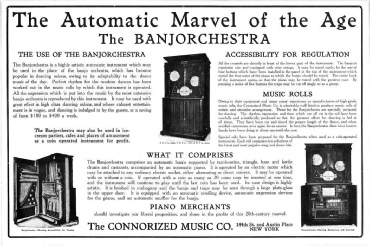
The Engelhardt Piano Company produced a variety of automatic musical instruments from about 1890 to the late 1920's under various names, Peerless being the best known. The two extant Banjorchestras were made by Engelhardt. The most complete was purchased by Rick Crandall, an Encore Automatic Banjo enthusiast, from Knott's Berry Farm in 1983. Dave Ramey was given the job of restoring this historic find. The instrument was serving as a "puppet show" nickelodeon. The banjo and traps had been removed and replaced with dancing puppets. The front soundboard remained where the banjo and traps were mounted and the placement of the banjo and traps could be seen by the shadows left by sun bleaching. The piano and banjo valve chests were left intact.
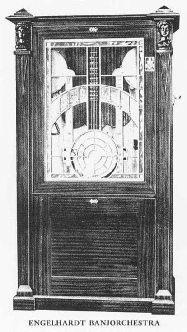
Although it is known what components comprised a Banjorchestra, since no original
rolls or even a tracker bar have been found it is not known how the music was arranged,
or how it actually sounded. The project languished for years. To help defer the costs
of engineering all the missing components and producing new music rolls, Dave decided
that he would go into production with his own version of the Banjorchestra.
Art Reblitz was brought into the project to help devise a tracker scale and develop
new music rolls. Dave and his son, David Jr, began designing the new instrument,
patterning it after the Connorized Banjorchestra, which allowed for a larger 61 note
piano. The new instrument was not really a reproduction of either makes of the original
Banjorchestra; several changes were made by design. Musically, the biggest change
was in the way the instrument would play. The new piano could play 61 notes, compared
to the original’s 42. This enabled the piano to play melody as well as accompaniment.
This greater range of musical abilities allows for more sophisticated musical arrangements
than the original Banjorchestra was capable of playing.
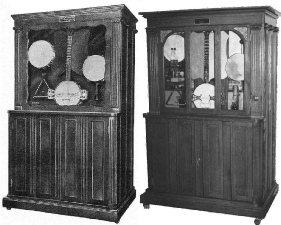
Once the new prototype Banjo-Orchestra was developed, the restoration of the original Engelhardt continued, ten years after the project began. The instrument was modified to utilize the new rolls and all their instrumentation. Soon, the first restoration of an original Banjorchestra was complete!
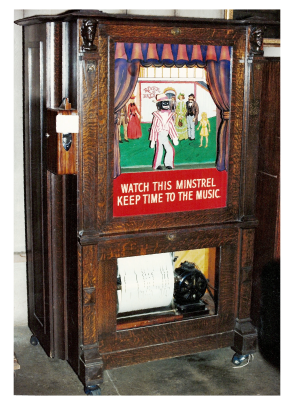

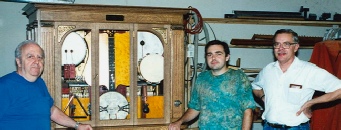
Dave Ramey, David Jr, and Art Reblitz in 1994.
The music rolls for the Ramey Banjo-Orchestra, of course, have to be specially arranged. Art Reblitz continues to arrange new ten-tune music rolls. Inspiration is drawn from many sources; original Encore rolls, 78 rpm recordings of the best dance bands of the period, arrangements from the best music rolls for coin pianos and orchestrions of other makers. This transcribing and adapting allows the Ramey Banjo-Orchestra to play some of the finest music ever arranged for automatic musical instruments. Unlike most American coin pianos, the music rolls for the Banjo-Orchestra are arranged to be played exclusively by this instrument. The music roll layout perfectly fits the instrument, rather than having to accommodate several models, each being different in its musical capabilities. This singularity of use results in a quality of music unlike anything normally heard from a coin piano.
To date, there have been 27 new Ramey models made , three of which feature a mahogany cabinet. After 100 years, the Banjorchestra lives on, hopefully, never to disappear again. The name “Ramey” may be on the new Banjo-Orchestra, but it took the talents of many people to realize the rebirth of this obscure American orchestrion.
Engelhardt Banjorchestra, restored
